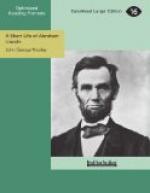The new stepmother quickly perceived the superior aptitudes and abilities of Abraham. She became very fond of him, and in every way encouraged his marked inclination to study and improve himself. The opportunities for this were meager enough. Mr. Lincoln himself has drawn a vivid outline of the situation:
“It was a wild region, with many bears and other wild animals still in the woods. There I grew up. There were some schools so called, but no qualification was ever required of a teacher beyond readin’, writin’, and cipherin’ to the Rule of Three. If a straggler supposed to understand Latin happened to sojourn in the neighborhood, he was looked upon as a wizard. There was absolutely nothing to excite ambition for education.”
As Abraham was only in his eighth year when he left Kentucky, the little beginnings he had learned in the schools kept by Riney and Hazel in that State must have been very slight—probably only his alphabet, or possibly three or four pages of Webster’s “Elementary Spelling Book.” It is likely that the multiplication table was as yet an unfathomed mystery, and that he could not write or read more than the words he spelled. There is no record at what date he was able again to go to school in Indiana. Some of his schoolmates think it was in his tenth year, or soon after he fell under the care of his stepmother. The school-house was a low cabin of round logs, a mile and a half from the Lincoln home, with split logs or “puncheons” for a floor, split logs roughly leveled with an ax and set up on legs for benches, and a log cut out of one end and the space filled in with squares of greased paper for window panes. The main light in such primitive halls of learning was admitted by the open door. It was a type of school building common in the early West, in which many a statesman gained the first rudiments of knowledge. Very often Webster’s “Elementary Spelling Book” was the only text-book. Abraham’s first




